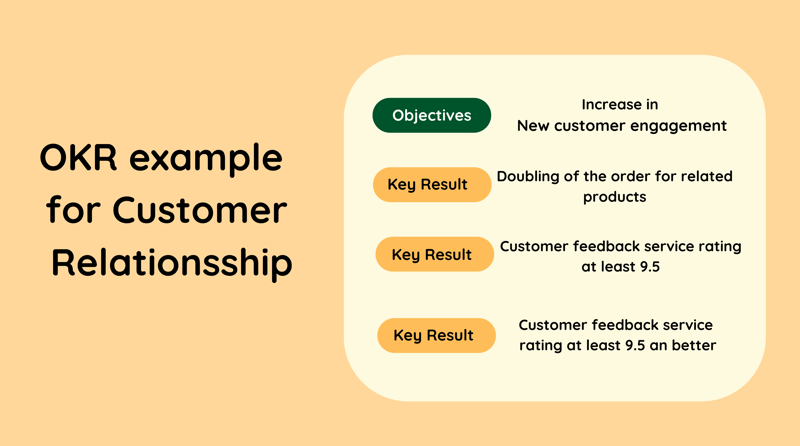Have your company's profits stayed the same even after an intensive marketing campaign? Are your customers unhappy? Or maybe there are quality issues in your production department? In any of these scenarios or others like them, you can successfully resolve the underlying problems with the objective and key results (OKR) method.
Anything that can be measured, can be evaluated and improved. OKRs go hand-in-hand with business goals. In our OKR guide, we summarized the approach, how to use it, and what sets it apart from other management methods. Below, we'll present a few real-world examples of how you can use the OKR method.
How to Properly Formulate an OKR?
An OKR is made up of objectives and key results. Its objectives are goals that are qualitative, result-oriented, challenging, and often abstract.
Key results, on the other hand, are specific, measurable, and contribute to achieving the objective. It's a good idea to have 3 to 5 of these milestones for each objective since they'll help show the way towards achieving your goal. Make sure that your key results are ambitious but doable, and capable of being regularly evaluated.

The formula below, from John Doerr (one of Google's co-founders), helps summarize the essence of the OKR method. Keep it in mind when formulating your OKRs so that they'll be as efficient as possible:
"I will accomplish 'X' Objective as measured by 'Y' Key Result."
Doerr's use of the present tense is intended to increase motivation and drive. Set 3 to 5 goals in your team, but know that experience has shown less is more.
Real-World OKR Examples
So, what do OKRs look like in practice?
OKR Example: Customer Relations
Suppose that you've discovered that your customers aren't satisfied and want to find out why. In this case, it makes sense to implement OKRs for any departments that interact directly with your clients.
For this scenario, the objective might be:
"We significantly increased customer satisfaction.“
Key results could include the following milestones:
- 1.
We made sure that customers left 5-star reviews for our products and services.
- 2.
Through the application of split tests in the ordering process, customer satisfaction increased from 2 to 4.5 stars.
- 3.
Customers recommending us to others grew from 15 to 30 percent.
OKR Examples: Purchasing
Are your suppliers experiencing delivery problems and becoming unreliable? If so, it's high time for an evaluation and intervention.
In this example, the objective is:
"Our suppliers are reliable and offer short delivery times that do not disrupt our production."
The key results here might be:
- 1.
We've identified two additional suppliers who can guarantee delivery times of no more than two days.
- 2.
After discussions with our existing supplier order times have been reduced to three days.
OKR Example: Marketing
Your business is engaged in content marketing, producing content that is relevant to its target groups and generates profitable leads. The objective below will make sure that your editorial team is on board with your goals:
"We create interesting and relevant content that encourages our readers to find out more and contact our sales team."
The key results in this scenario could be:
- 1.
We increased the click rate by three percent per week.
- 2.
The content download rate has risen by 10 percent.
- 3.
Our sales department has received 10 percent more customer inquiries.
OKR Example: Production
The OKR method isn't just for marketing: It can be applied to nearly any area of your business, including the production department. Do your products have too many defects or is the rejection rate well above average? If so, it's time to gather your team and set a new target!
A good objective in this scenario might be:
"We produce a high-quality product with an extremely low rejection rate.“
These key results might be formulated:
- 1.
We optimized our production process and reduced our rejection rate from six to two percent.
- 2.
Production has become more cost-effective and increased in quality.
- 3.
Our customers are 100 percent satisfied with the quality of our products.
OKR Example: Management
The above examples have all involved businesses and specific departments, however, OKR can also be applied to teams or even individual employees. Whereas staff generally tries to achieve OKRs, their results are often analyzed by the organization's leadership. A good example would be an OKR regarding employee satisfaction, a key element in ensuring corporate success.
A department head or manager might set the following goal:
"My employees are satisfied because I've supported their ongoing training and made available a budget for personal development."
Key results could be:
- 1.
The number of employees participating in training programs has increased by 10 percent.
- 2.
The percentage of employees taking advantage of the budget for personal development has increased by 15 percent.
- 3.
Employee satisfaction has grown from an average score of 6/10 to 9/10.
OKR Example: Daily Routine
Even outside of the business world, OKRs have all sorts of uses, including in your private life. After all, OKRs help those who formulate them to achieve specific goals or targets. The benefits are multiplied when combined with a vision board.
Good resolutions, like losing weight or exercising more can become hard to stick with over time. Would you like to walk or run more over the next few months? If so, your personal OKR might look like this:
"I'm so fit that I could run a marathon."
The key results could be:
- 1.
Every week, I walk 10,000 more steps than the week before.
- 2.
Once per week, I jog for half a mile.
- 3.
Four days per week, I ride 20 miles on a spinner bike.
Conclusion
The best way to achieve any goal is to have a clear path forward. Although it sounds like common sense, many businesses and organizations have trouble formulating their goals and the steps needed to achieve them. Even though OKR isn't new, but more of a modern twist on existing management methods, it can definitely help.
However, there are some risks to take into account: Inconsistent execution, setting goals that are too easily achievable, and the absence of numerically defined key results will doom even the most well-intentioned OKR to failure.
FAQs
While objectives should never include any numbers, they are essential to key results. After all, progress needs to be measurable, specific, and have some correlation to time. Well-formulated key results include concrete dates, data, and numbers.
Any business that communicates openly and transparently can benefit from the OKR method. It's particularly useful for start-ups since it's a great tool for quickly and efficiently developing a business. Even in your personal life, you can adapt the OKR method to consequently set and achieve your goals.
Yes, the OKR method is applicable to any department or area of a business. Make sure that the entire team and all participants are on board though, since you'll need to set ambitious goals and monitor the achievement of specific milestones.
OKR is not a magic wand. Some of the most common reasons why OKRs fail include a lack of focus, non-measurable key results, inconsistency in application, and differences between corporate and team goals. In addition, another common pitfall is unclear or misunderstood communication during the OKR's implementation.
A good objective always describes the goal to be accomplished. Since it's a target, any objective observer should be able to judge it as completed or missed once the cycle is completed. For that reason, objectives need to be goal-oriented and qualitative, rather than quantitative. Objectives are always transparent, clearly formulated, inspirational, and positive.






